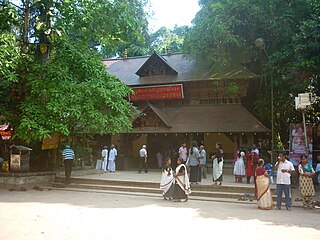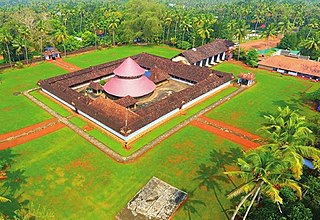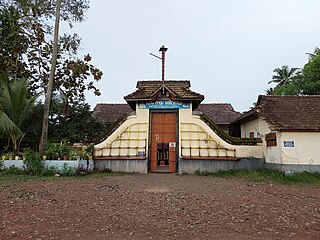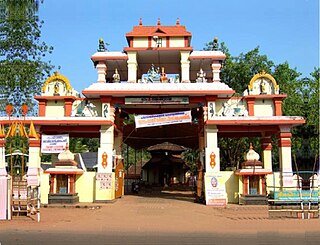
Mavelikara is a municipality in the Alappuzha district of Kerala, India. It is located 43 km (26.7 mi) south of the district headquarters in Alappuzha and about 95 km (59.0 mi) north of the state capital Thiruvananthapuram. As per the 2011 Indian census, Mavelikara has a population of 26,421 people, and a population density of 2,088/km2 (5,410/sq mi).
Odanad was a feudal state in late medieval Kerala. It was established in the 11th century, and disestablished in 1746 when it became part of Travancore after Venad King Marthanda Varma's northern expedition. The last king of Odanad was King Kotha Varma. At the time of its dissolution, it was composed of the present-day taluks of Mavelikkara, Karthikapally, Chenganur in the Alappuzha district and Karunagapally in the Kollam district. Another name of onattukara is kayamkulam. In the 15th century, the capital of Odanad was moved from Kandiyoor-Muttom to Eruva and Krishnapuram in Kayamkulam, which led to the state being called Kayamkulam. After this shift, Kayamkulam became the commercial centre of Odanad, while Mavelikkara remained its cultural centre. Odanad was controlled by Nair lords, among whom the ruler of Kayamkulam was the most prominent.

Achankovil is a 128 km (80 mi) long west flowing river in Kerala, India. It flows through the districts of Kollam, Pathanamthitta and Alappuzha. The river drains vast tract of fertile plains of Upper Kuttanad in the Alappuzha and Pathanamthitta districts. It also sustains numerous urban settlements along its course such as Konni, Pathanamthitta, Pandalam and Mavelikkara.

Pandalam is a municipality in the Pathanamthitta district of Kerala, India. Pandalam is known for its connection with Ayyappan and Sabarimala. It recognised as the cultural capital of Travancore, Pandalam hosts educational institutions ranging from reputed schools to post graduate, training, Ayurveda, and engineering colleges. There are seven colleges and 23 schools at Pandalam, including N. S. S. College, Pandalam. The Kerala state government plans to make the place a special Township, by including the Pandalam municipality and Kulanada panchayat.
Mannar is a census town in Chengannur Taluk in Alappuzha District of Kerala state, India, on State Highway 6. It is also known as the Bell Metal Town.
Padanilam is a town located in Onattukara region of Alappuzha district, Kerala. The word Padanilam means "land of battles". It is located on the banks of river Achankovil. The Padanilam temple is one of the important centres of worship in Kerala. Nooranad is named as the Nandikesha Paithruka Gramam by the Government of Kerala due to its importance in kettukala construction, which is an icon of Onattukara region.

Mannarasala Sree Nagaraja Temple in Haripad is a very ancient and internationally known centre of pilgrimage for the devotees of serpent Gods (Nagaraja). The famous Nagaraja temple "Mannarasala" in Haripad is nestled in a forest glade, like most snake temples. The Mannarasala Temple has over 100,000 images of snakes along the paths and among the trees, and is the largest such temple in Kerala, India. Couples seeking fertility come to worship here, and upon the birth of their child come to hold thanksgiving ceremonies here, often bringing new snake images as offerings. A special turmeric paste which is available at the temple is credited with curative powers.

Anandavalleeswaram Sri Mahadevar Temple in Kollam city is one of the ancient Hindu temples in Kerala, India. Lord Siva and Goddess Anandavally are the main deities of the temple. According to folklore, sage Parashurama has installed the idol of Lord Shiva. The temple is a part of the 108 famous Shiva temples in Kerala. It is located at Anandavalleeswaram, a major neighborhood of Kollam city, that comes to the west side of Kollam Collectorate.

Krishnapuram is a village in Alappuzha district in the Indian state of Kerala.

The Sree Subrahmanya Swamy Temple (Perumthrikkovil), also known as Kerala Palani or Dakshina Palani (lit. 'Southern Palani'), in Haripad, Kerala, is one of the oldest and largest temples in the region. According to belief, the temple predates the beginning of Kali Yuga. This temple holds the distinction of being the largest Subrahmanya Swami Temple in Kerala, and features the longest golden flagpost, known as the dhwajastambha (kodimaram in Malayalam). The temple's main deity is believed to embody not only Subrahmanya Swamy but also Lord Shiva and Lord Vishnu, making it a highly revered and powerful place of worship.

Kanjiramattam Sree Mahadeva Temple, is an ancient Hindu Temple in Idukki district situated on the bank of Thodupuzha River at Kanjiramattam Kara in Thodupuzha Taluk. The temple is located about one and a half kilometers south east of Thodupuzha KSRTC bus stand. It is believed that Kanjiramattam Sree Mahadeva Temple is one of the 108 Shiva temples of Kerala and is installed by sage Parasurama dedicated to Lord Shiva. The deity in the temple is depicted as meditating under a KalpaVriksha with his consort Parvati.The Temple is built in Kerala style of architecture. The sub-deities of the temple are Durga, AmrithakalasaSastha, Ganapati, Vanadurga, Naga deities, Sri Mookambika Devi and Rakshass.

Mannar Thrikkuratti Mahadeva Temple an ancient Hindu temple dedicated to Shiva is situated on the banks of the Pampa river at Mannar of Alappuzha in Kerala state in India. The presiding deity of the temple is Shiva, located in main sanctum sanatorium, facing East. According to folklore, sage Parashurama has installed the idol. The temple is one of the 108 famous Shiva temples in Kerala. It is believed that the mammoth temple compound wall was built by a troupe of Bhootas of Lord Paramasiva in one night. The temple was built by King Maandhatha of Ishyaku Dynasty (Sooryavamsam).

Niranam Thrikkapaleeswaram Dakshinamurthy Temple, an ancient Hindu temple dedicated to Lord Shiva is situated on the banks of the Pampa river at Niranam of Pathanamthitta District in Kerala state in India. This temple is a classic example of the Dravidian style of architecture. The temple is the abode of Dakshinamurthy. The deity of Thrikkapaleeswaram is located in main Sanctum Sanctorum facing east. According to folklore, sage Parasurama has installed the idol. The temple is a part of the 108 famous Shiva temples in Kerala. This is one of the three Thrikkapaleeswaram temples mentioned in 108 Shiva temples. Two other temples situated in Peralassery in Kannur district and Nadapuram in Kozhikode district.

Nadapuram Iringannur Siva Temple, is an ancient Hindu temple dedicated to Lord Shiva is situated at Iringannur village of Kozhikkode District in Kerala state in India. The temple deity of Iringannur Siva temple is Dakshinamurthy and are located in separate sanctum sanctorums facing east. According to folklore, sage Parasurama has installed the idol and the temple is a part of the 108 famous Shiva temples in Kerala. This is one of the three Thrikkapaleeswaram temples mentioned in 108 Shiva temples sothram and other two temples situated in Niranam in Pathanamthitta district and Kadachira in Kannur district.

Avittathur Mahadeva Temple, an ancient Hindu temple dedicated to Lord Shiva is situated at Avittathur village of Thrissur District in Kerala state in India. Avittathur gramam (village) is one of the 64 original Brahmin settlements in the ancient Kerala. The Avittathur temple as well as Avittathur Gramam is equally famous like Thaliparamb gramam, Sukapuram gramam, Irinjalakuda gramam and Peruvanam gramam. Avittathur Mahadeva Temple is more than 2000 years old and four old inscriptions have been discovered. According to folklore, sage Agastya has installed the idol of Lord Shiva. It is also believed that the temple's shiva lingam was installed by lord Parasurama the sixth incarnation of Lord Maha Vishnu. The temple is a part of the famous 108 Shiva temples of Kerala.

Talikotta Mahadeva Temple or Thaliyil Mahadeva Temple, an ancient Hindu temple dedicated to Shiva is located on the banks of Meenachil River on Kottayam - Kumarakom Road in Kottayam District in Kerala state in India. The Keezhtali Mahadeva Temple is one of the important temples in Thekkumkur Kingdom. According to folklore, sage Parashurama has installed the idol of Shiva. The temple is a part of the 108 Shiva Temples in Kerala. The temple is one of the four thali temples mentioned in the 108 Shiva temple sothram The temple houses Lord Shiva in his most angry form. There are sub-shrines for Ganapathi, Ayyappan and Bhadrakali in the temple.

Padanayarkulangara Mahadeva Temple is an ancient Hindu temple dedicated to Lord Shiva is situated on the banks of the Pallikkal River at Karunagappally town of Kollam District in Kerala state in India. The temple is a part of the 108 famous Shiva temples in Kerala.

Sree Perunthatta Siva Temple is an ancient Hindu temple dedicated to Lord Shiva situated in Guruvayur of Thrissur District in Kerala state in India. According to folklore, sage Parashurama has installed the idol of Lord Shiva in the Treta Yuga. The temple is a part of the 108 famous Shiva temples in Kerala. Therefore, the Saiva-Vaishnava glow is a holy abode.
Palayur Mahadeva Temple was a legendary temple located in Palayoor near Chavakkad in the Thrissur district in ancient Kerala. This Shiva temple was later converted into a Christian church with the arrival of St. Thomas in Malabar, Kerala. Palayoor Mahadeva (Siva) Temple does not exist today. The temple is believed to be constructed by the first Chera king of Kodungallur. This temple is one among the 108 Shiva temples established by Parasurama. The legends suggest that the installation of the idol of god Mahadeva (Shiva) was performed by Parasurama himself.



















